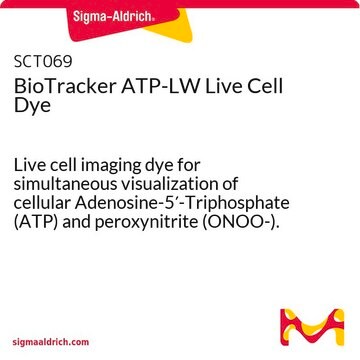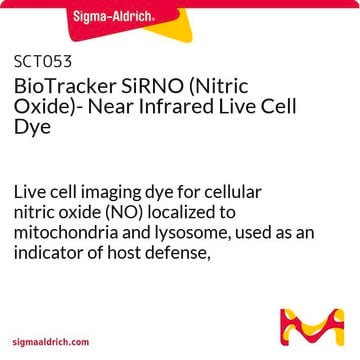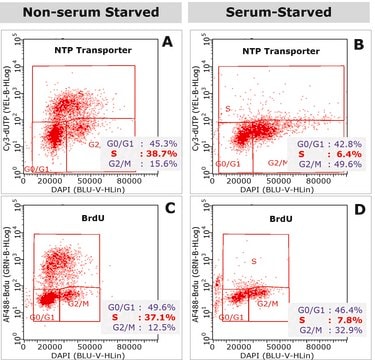SCT045
BioTracker ATP-Red Live Cell Dye
Live cell imaging dye for cellular adenosine triphosphate (ATP) localized to mitochondria used to detect metabolic activity, cell proliferation and overall cell health.
Synonim(y):
Live cell imaging probe
Zaloguj sięWyświetlanie cen organizacyjnych i kontraktowych
About This Item
Kod UNSPSC:
12352207
NACRES:
NA.47
Polecane produkty
Próba
≥98% (H-NMR)
≥98% (HPLC)
≥98% (LC/MS)
≥98% (elemental analysis)
metody
cell based assay: suitable
metoda wykrywania
fluorometric
Warunki transportu
ambient
Opis ogólny
Adenosine triphosphate (ATP) is the primary energy source for all cellular processes. ATP also functions as a signaling molecule for regulating cell movement, neurotransmission and ion channel functions. ATP is localized in mitochondria, where cellular respiration occurs. ATP levels can be used to measure cell proliferation and cell cycle dynamics.
The BioTracker ATP-Red dye is a live cell red fluorescent imaging probe for adenosine triphosphate (ATP). The probe targets ATP specifically in the mitochondria of living cells. The probe shows no cross reactivity to numerous analytes including: Zn2+, Mg2+, Ca2+, Na2+, K+, GSH, HOCL, H2O2, arabinose, galactose, glucose, fructose, ribose, sorbose, sucrose, xylose, heparin, AMP, ADP, CMP, CDP, CTP, UMP, UDP, UTP, GMP, GDP or GTP. The probe is non-fluorescent when forming a closed ring structure. In the presence of the negatively charged ATP, the covalent bonds between boron and ribose is broken and the ring opens producing fluorescence.
Spectral Properties
Absorbance: 510nm
Emission: 570nm
The BioTracker ATP-Red dye is a live cell red fluorescent imaging probe for adenosine triphosphate (ATP). The probe targets ATP specifically in the mitochondria of living cells. The probe shows no cross reactivity to numerous analytes including: Zn2+, Mg2+, Ca2+, Na2+, K+, GSH, HOCL, H2O2, arabinose, galactose, glucose, fructose, ribose, sorbose, sucrose, xylose, heparin, AMP, ADP, CMP, CDP, CTP, UMP, UDP, UTP, GMP, GDP or GTP. The probe is non-fluorescent when forming a closed ring structure. In the presence of the negatively charged ATP, the covalent bonds between boron and ribose is broken and the ring opens producing fluorescence.
Spectral Properties
Absorbance: 510nm
Emission: 570nm
Zastosowanie
Live cell fluorescent imaging
Research Category
Cell Imaging
Cell Imaging
Research Sub Category
Live Cell Dye
Live Cell Dye
Jakość
Purity: ≥ 98% confirmed by HNMR, LC-MS and HPLC and elemental analysis
Molar Mass: 561.48 g/mol
Molar Mass: 561.48 g/mol
Postać fizyczna
Lyophilized
Przechowywanie i stabilność
Store BioTracker ATP-Red Live Cell Dye at -20°C, desiccate and protect from light
Note: Centrifuge vial briefly to collect contents at bottom of vial before opening.
Note: Centrifuge vial briefly to collect contents at bottom of vial before opening.
Oświadczenie o zrzeczeniu się odpowiedzialności
Unless otherwise stated in our catalog or other company documentation accompanying the product(s), our products are intended for research use only and are not to be used for any other purpose, which includes but is not limited to, unauthorized commercial uses, in vitro diagnostic uses, ex vivo or in vivo therapeutic uses or any type of consumption or application to humans or animals.
This page may contain text that has been machine translated.
Kod klasy składowania
11 - Combustible Solids
Klasa zagrożenia wodnego (WGK)
WGK 3
Temperatura zapłonu (°F)
Not applicable
Temperatura zapłonu (°C)
Not applicable
Certyfikaty analizy (CoA)
Poszukaj Certyfikaty analizy (CoA), wpisując numer partii/serii produktów. Numery serii i partii można znaleźć na etykiecie produktu po słowach „seria” lub „partia”.
Masz już ten produkt?
Dokumenty związane z niedawno zakupionymi produktami zostały zamieszczone w Bibliotece dokumentów.
Klienci oglądali również te produkty
Lu Wang et al.
Angewandte Chemie (International ed. in English), 55(5), 1773-1776 (2015-12-18)
Adenosine triphosphate (ATP), commonly produced in mitochondria, is required by almost all the living organisms; thus fluorescent probes for monitoring mitochondrial ATP levels fluctuation are essential and highly desired. Herein, we report a multisite-binding switchable fluorescent probe, ATP-Red 1, which selectively
Nasz zespół naukowców ma doświadczenie we wszystkich obszarach badań, w tym w naukach przyrodniczych, materiałoznawstwie, syntezie chemicznej, chromatografii, analityce i wielu innych dziedzinach.
Skontaktuj się z zespołem ds. pomocy technicznej















